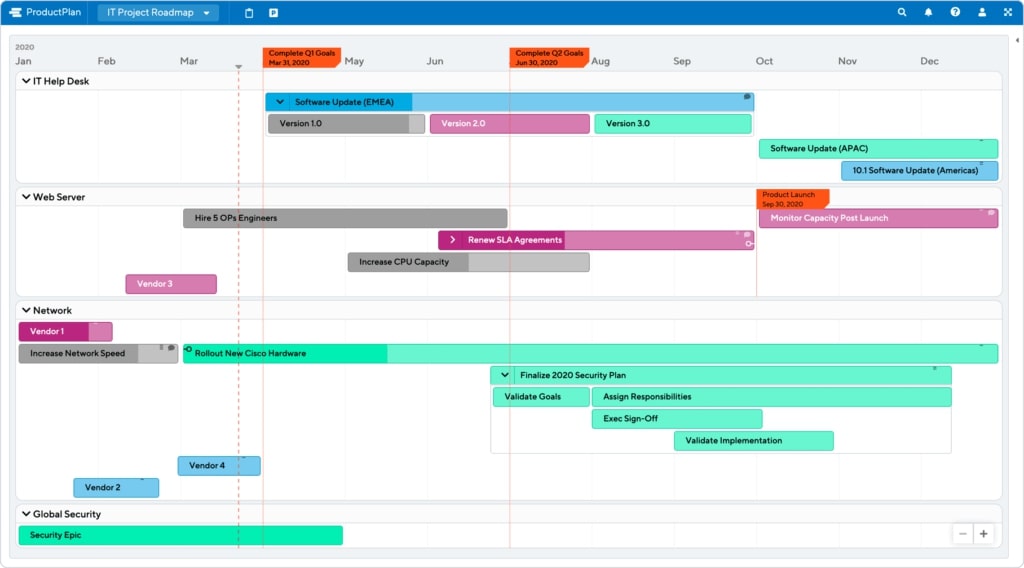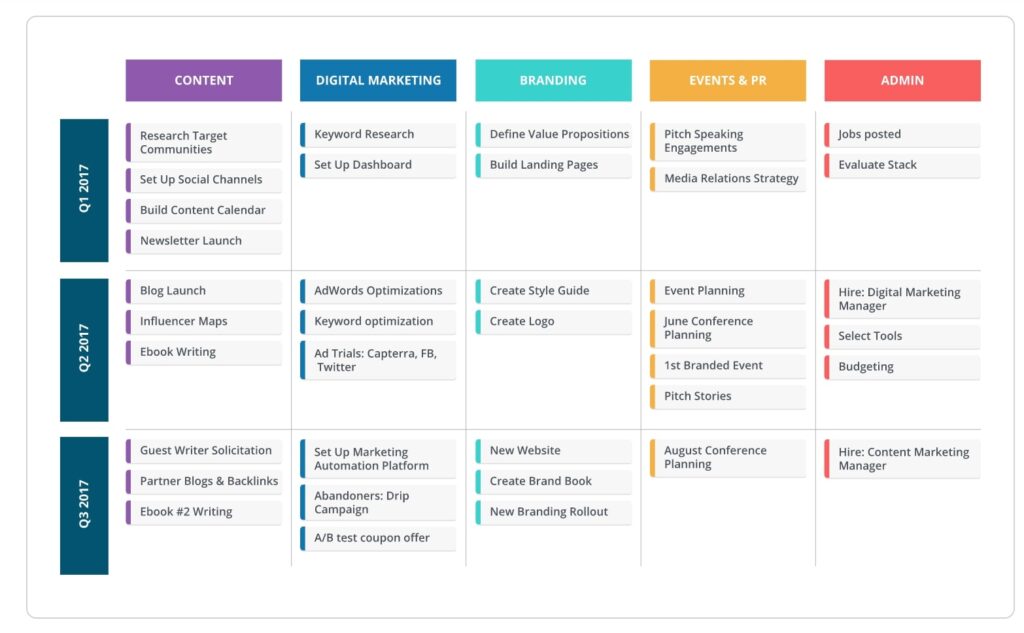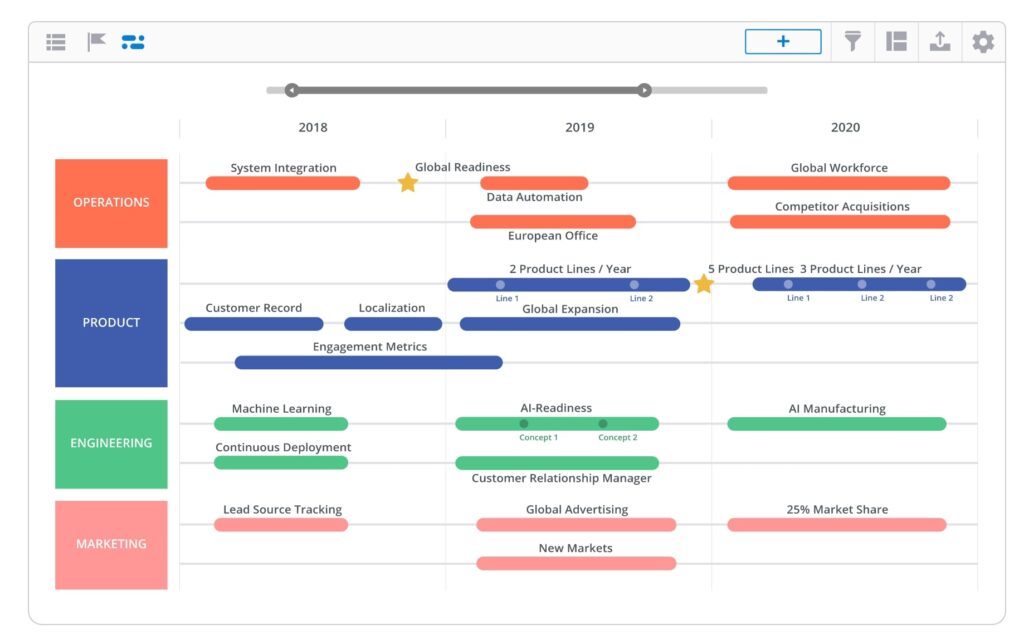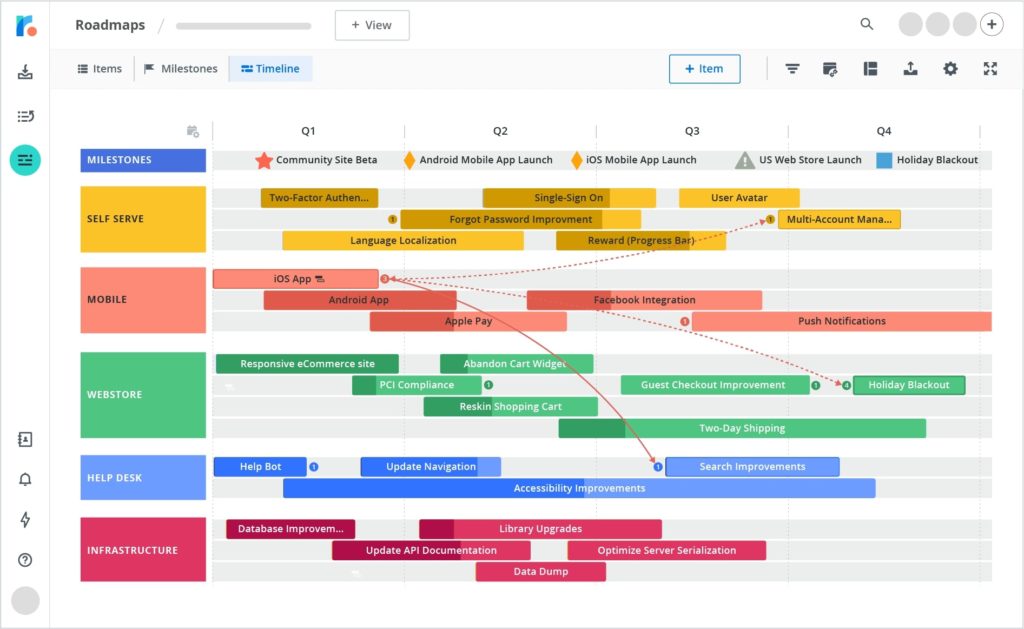The traditional roadmap provides you with directions on how to move from where you are to the destination you have in mind. The product roadmap serves the same function. It shows how the product strategy becomes a reality.
Get the product roadmap right, and the entire team understands your product strategy and how they play a role in helping you to achieve your company’s goals.
This post shares 13 practical tips that help you create an impactful product roadmap that communicates your product vision and aligns your stakeholders.
1. Keep it Simple
The product roadmap is not the place to show that you’re a wordsmith or that you’ve determined the detailed execution steps.
Do not add too many details. Instead, stick to the important elements. Clear and concise thinking is the hallmark of the best product roadmaps. When you build a product roadmap, exclude unnecessary information.

Credits: Product Plan
Keep in mind that the roadmap is a strategic product plan, and not a detailed product plan showing execution steps. Using a product vision board template helps to focus your mind on what matters and keep it simple.
2. Align With the Organization’s Vision
Every organization has a vision which is an expression of how its activities impact the world or make things different. Create a product roadmap that aligns with this vision and your key stakeholders.
The first tip to making an inspiring product roadmap is to connect it to the organization’s vision. This starts with having a product strategy, which is an explanation of how the development supports the business.

Credits: Medium
Thus, a big consideration when bringing anything into your product roadmap is not that it satisfies someone’s needs but that it is crucial to realizing the company’s vision.
3. Collaborate With Key Stakeholders
To have an impactful product roadmap, do not build it on your own. Remember that a roadmap is a communicative tool for a lot of team members. This includes those that develop, market, and sell the product. Thus, there are a lot of people that add value to the roadmapping process.
Be open to ideas and to involving different people. Create environments to receive input from these other people that interact with the roadmap, whether that’s an internal roadmap or an external roadmap.
By collaborating with others, you’ll find it easier to develop realistic constraints, identify dependencies, pinpoint risks, obtain stakeholder buy-in, and more.
4. Secure a Strong Buy-in
A product roadmap is useless if other external stakeholders or internal stakeholders do not support it. This is one reason why you engage relevant stakeholders when creating and updating the roadmap.
Your product roadmap is impactful if you get others to support the plan. This buy-in is crucial when considering other factors such as how young your product is. Having a strong strategic roadmap helps to increase confidence among stakeholders and rally them around your vision.
5. Goal-Oriented Roadmaps Always Win
Two important elements of a product roadmap are goals and features. Goals (or outcomes) are the benefits that the product creates for the users and the business. Sample goals include acquiring customers and increasing engagement.
Features are distinctive attributes that the products need to have to meet the goals.

Credits: Road Munk
While product roadmaps include some features, put the emphasis on the goals. A feature-laden product roadmap turns your roadmap into a to-do list.
This comes with the risk of workers going through the motions, and focusing on crossing features off the list. A goal-based roadmap comes with scrutinizing activities and adjusting the roadmap as the product evolves.
6. Evaluate and Review Ideas
You are never short of ideas when it comes to deciding what to put in your roadmap.
As valuable as every idea is, not everything makes it to the plan. To know what ideas go into the product roadmap, evaluate every idea. Score the ideas based on what matters most to critical stakeholders and the overall vision of the company.
It is easy to appease people and through any idea into your goal-oriented roadmap template but care and consideration are always important to achieve business goals.
7. Use Measurable Goals
It is not enough to establish your vision and define the strategic goals. Find a way of knowing that your team is achieving its goals. Incorporate those metrics in your product roadmap to make them specific and measurable.
For example, if a goal is to acquire new users, mention how many users you’re targeting. Also compare your results with industry averages, to determine how you’re performing in relation to competitors.

Credits: Roadmunk
A goal-oriented roadmap allows product managers to track progress and create more efficient product teams. Without a measurable target, it is difficult to achieve strategic objectives. Make a roadmap measurable and it’s much easier to follow.
8. Be Realistic
Make your project roadmap realistic. Have realistic goals, along with realistic constraints like time and cost.
Unrealistic expectations add significant risks to the project. For example, unrealistic deadlines cost delays, leading to cost overruns, shoddy deliverables, and more.
They also have a huge negative effect on the morale of your development team or product team if they don’t meet a goal.
9. Acknowledge Risks
Every initiative comes with risks. The success of an initiative boils down to risk management. Thus, an important tip to a successful product roadmap is to acknowledge risks. Mention all unknowns as well as your mitigation strategies for each one.
Acknowledgment of risks also helps you get stakeholders’ buy-in. It tells everyone that you are not consumed by wishful thinking but have full awareness of and control over potential threats.
10. Provide a Holistic View
Even in many small organizations, products do not exist in a vacuum. A product connects to other products or services to form the unique solution that your organization offers.
Make your product roadmap reflect this. You achieve this via a portfolio view. This involves showing how the product fits in with the other products or services of the organization towards achieving broader organizational goals.
11. Build an Agile Product Roadmap
As every business knows, the market changes. For this reason, every product management and development team today describes itself as “agile,” referencing the importance of responding to changes in your market.

Credits: Roadmunk
Thus, build an agile product roadmap. Make room for flexibility, being sure to allow for reevaluation and reaction to the market. One way of making your product roadmap agile is to not dwell on specifics of particular features and details of implementation, but rather to allow it to communicate high-level agenda.
12. No Surprises During Roadmap Presentation
The last stages of the product roadmapping planning process include a presentation to gain acceptance and approval for the plan.
To ensure express approval, ensure that there is nothing in your presentation that comes as a surprise to the relevant stakeholders.
This means that in the process, you did not stop at getting input, but you communicated every plan. Thus, everyone knows what’s coming, and the presentation becomes like a formality.
13. Employ Visual Information
Humans gravitate toward things that are appealing. What it contains may matter as much as how your product roadmap looks.
So, instead of using plain text, liven your product roadmap with visual information with pictures, charts, and progress bars, among others.
Product Roadmap Tips: Final Thoughts
Your team deserves a product roadmap that communicates the vision and direction of your product. The 13 tips above help you to create an impactful product roadmap.
Keep it simple, align goals with the company’s vision, collaborate with relevant stakeholders, and get their buy-in.
Make the roadmap goal-oriented instead of features-based, and use measurable goals. Use realistic expectations, acknowledge all risks, make the roadmap flexible, and employ visual information.